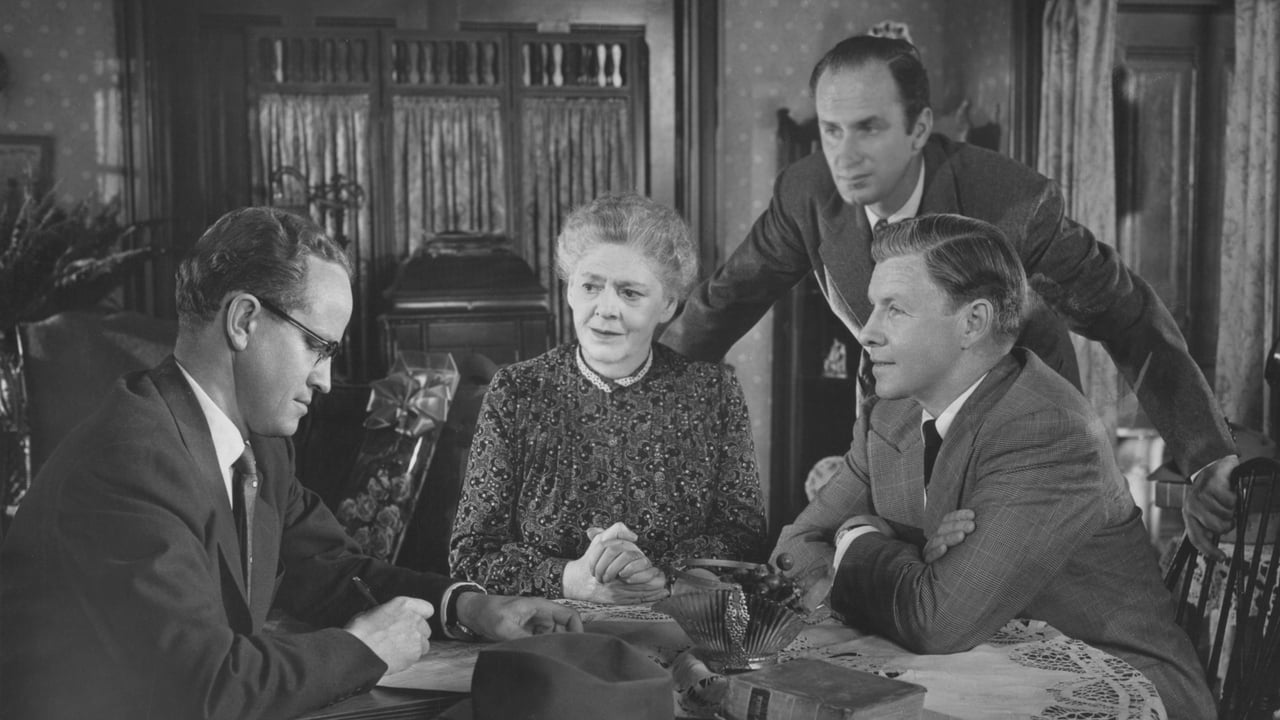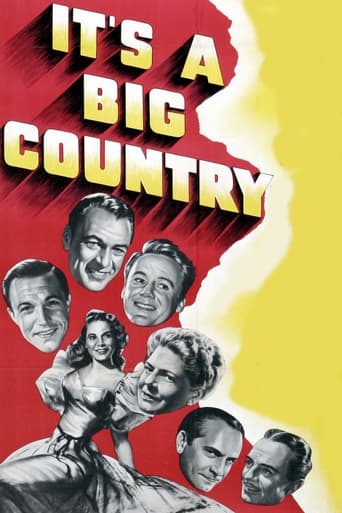

"It's a Big Country: An American Anthology" is a very unusual movie and is clearly a product of its times. While such a schmaltzy bit of unabashed patriotism and propaganda would be laughed at today, following WWII and in the midst of the Red Scare, it all made perfect sense back in the day. It was intended to hammer home the goodness of America and its people...though perhaps it comes on a bit strong here and there.The film is made up of eight different stories. To me, this is the biggest weakness of the film. Perhaps paring it down to three or four stories would have worked better...especially since some of the stories are underdeveloped or just didn't work all that well. Here's a breakdown of the stories:1. Two guys are on a train. One is a loudmouth (James Whitmore) and he strikes up a conversation with a guy who seems, at first, to just want a bit of peace and quiet (William Powell). This one was very forgettable and a bit stupid. This one merits a 3.2. Ethel Barrymore plays a lonely widow who was somehow missed in the census. With the help of a newspaper editor (George Murphy) she gets counted. VERY schmaltzy and utterly ridiculous, this one is still very enjoyable and merits a 6.3. In a tribute to the accomplishments of Black Americans, a montage of famous Blacks is shown while the narrator describes their many achievements and contributions. This is totally unlike most of the rest of the film and instead of a fictional story, it's a mini- documentary. For 1951, it's very liberal and positive...though folks today will likely think it's a bit of a 'whitewash' by making everything look too positive for this minority group. Despite this, I think it's quite good for the time in which it was made and I give it an 8.4. Mr. Szabo (Cuddles Sakal) is a Hungarian man with many daughters...who he dearly loves. However, Mr. Szabo is a bigot when it comes to Greeks--he hates them and insists Hungarians ALWAYS will hate Greeks. Not surprisingly, his oldest daughter (Janet Leigh) ends up falling for a Greek (Gene Kelly) and this causes many problems...as well as forces Mr. Szabo to examine his own prejudices--hammering home the message that Americans should be united. However, I do wonder-- do Greeks and Hungarians really dislike each other? I don't think this has ever been true...and would love to know more from anyone who knows more about this. Making Kelly and his brothers Turkish-Americans...that would have made a lot more sense since there has been a long, long tradition of distrust and dislike between these groups. This segment easily could have been longer and more developed and was one of the more enjoyable segments thanks, as always, to the wonderful Cuddles Sakal. Of course, I'd love him in ANYTHING! 8.5. A Jewish soldier (Keefe Brasselle) returns home from the Korean War. Among the first things he does is visit the mother (Marjorie Main) of a fallen buddy. The message is about more than tolerance for others but about our need for each other--and the strength Americans derive from its many ethnic groups. EXTREMELY preachy and schmaltzy but well done. 6.6. This is a bizarre one. The narrator begins talking about Texas when Gary Cooper (dressed as a cowboy) interrupts and begins talking at length about his beloved Texas (though Cooper was actually from Montana!). It plays much like a travelogue...to a foreign country! This is among the shortest segments and is kind of funny...and forgettable. 6.7. Van Johnson plays a young minister who has just arrived in Washington, DC and the church is the same one the President usually attends. His preaching sucks--mostly because he is more concerned with impressing the President than the congregation. Among the least watchable of the segments, 3.8. Nancy Davis (Reagan) plays a school teacher who notices that an Italian-American kid cannot see very well...so she sends a note home. The father (Frederic March) is angry...his son sees just fine...or so he thinks. He's so upset he goes to see the teacher about this. Somehow, this idiotic father thinks that needing glasses is the same has having a hearing problem. Huh?! Well, regardless, the teacher has a tough time getting through to him. This segment seems to have less lot to do with the overall theme of the film but was okay otherwise. 5.Overall, this is a fair film--with several really good portions and several which just don't work well. In many cases, by allowing the story to slowly reveal itself would have made the message less preachy and obvious. Subtle, it ain't but an interesting little experimental film.
... View More"It's a Big Country" is a significant film. Created only a few years after the victorious effort of WWII, it was delivered to an American public that was exercising newfound powers, economic and political. It was a society undergoing rapid change for the same reasons and also due to changing mores in gender and race relations (caused by war experiences) and due to changes in technology and infrastructure (the car, interstate highways, etc.). The film fairly pleads for factions of the country to remain united despite their tendency to seek their own identities.This film feels like a moving representation of Norman Rockwell paintings, displaying a homespun, good-natured respect for traditions and the values that drove the United States to become successful. From the viewpoint of the 21st century, some of these values seem naïve. In our post-Watergate world, fewer Americans see government authority and other established authorities as innately benign. But it is simplistically easy to view this film as merely propaganda or naïve.Most of the episodes in this collection of vignettes champion values that were and are important to embrace: Racial understanding. The American melting pot. The Constitutional freedoms. But reading some reviews of the film, it is clear that some viewers also see the film as a documentary on American exceptionalism. And it's a subtext that cannot be ignored. Various individuals have always promoted the idea that America is the greatest country that ever existed--teachers, politicians, the military, the clergy. The thing that is exceptional and unique about the U.S. is its Constitution. Sometimes that message is lost in the nationalistic clamor.The film has an exceptional cast (Frederic March continues to amaze), exceptional writing that stirs the heart and summons tears, and solid production values. For those of any age, it can serve as a marker designating the state of the country circa 1950. So many complex factors have affected the evolution of the U.S. from what it was to what it is now. I like being reminded of the optimism of that time, however naïve. And it can remind us of the values we need to preserve and the viewpoints we have thankfully left behind.
... View MoreI understand this film did poorly at the box office. And I understand. A lot of it is pretty uninteresting, although its intent -- to instill pride in America -- was admirable. What's interesting about this "flop" were the big stars in it: Ethel Barrymore, Gary Cooper, Nancy Davis (not a big star, but the future First Lady), Van Johnson, Gene Kelly, Janet Leigh, Marjorie Main, Fredric March, George Murphy, William Powell, S.Z. Sakall, James Whitmore, and Keenan Wynn.So how did a film with such a stellar cast flop? It was 8 unrelated "skits" about some aspect of American life. So each star was on camera for maybe 5-10 minutes only. Some of the stories were dumb and/or boring. Lots of propaganda-type film in between. A couple of the stories were interesting -- for example the Italian family segment (headed by Fredric March) was well done, as was the census story headed by Ethel Barrymore.This is NOT one for your DVD shelf, but is worth one watch for the big stars.
... View MoreI doubt if a film like It's A Big Country could be made in and about the America of post Vietnam and Watergate. A whole lot of the clichés presented here just aren't bought any more by large segments of the population. For whatever it's worth the film is a presentation of what we thought about ourselves in 1951.It's a film with several different segments, some serious some pretty funny about every day Americans in all walks of life, in all parts of the then 48 states.The two I liked best were those that ironically starred the two men who were not MGM contract players, Gary Cooper and Fredric March. Gary Cooper plays a Texas cowboy talking about his state and disillusioning us with a tongue in cheek delivery about the way Texans and Texas are perceived by the other 47 states. Of course Cooper's humor and the whole premise behind this segment was that Texas was our largest state in land mass. That ended in 1959 when Alaska became the 49th state, still it's the highlight of It's A Big Country.Fredric March plays an Italian American father who's opposed to his son, Bobby Hyatt, getting needed glasses even after teacher Nancy Davis tells him it's necessary. He's got some old world ideas that need a bit of adjustment. March plays the role with dignity never do you feel he's a caricature.Another episode that is nicely done involves Gene Kelly, Greek American boy falling for Janet Leigh, Hungarian American girl. They've got a problem though, her father played by Hollywood's number one Hungarian S.Z. Sakall. In the past 20 years we've seen a whole lot of stories about ancient ethnic hatreds coming out of Eastern Europe. Sakall is carrying some old grudges against Greeks though he really isn't sure why. Point being that here in America you're supposed to leave that all behind. That segment is still very much relevant.Could we make It's A Big Country today? Not at this time, maybe at some future point when we've reached a national consensus that despite all our problems, America's a pretty good place after all.
... View More